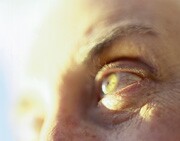- Big Health Care Disparities Persist Across the U.S., New Report Finds
- Teens Often Bullied Online About Their Weight: Study
- Work That Challenges Your Brain Helps You Stay Sharp With Age
- Urine Test Might Spot Head-and-Neck Cancers Early
- Many Seniors Are Overmedicated, But ChatGPT Might Prevent That
- Antipsychotics May Do Great Harm to People With Dementia: Report
- Two-Drug Combo Curbs Drinking for People Battling Severe Alcoholism
- Most Homeless Americans Are Battling Mental Illness
- FDA Recalls Heart Failure Devices Linked to Injuries and Deaths
- COVID Does Not Spur Asthma in Kids, Study Finds
Low-Income Southerners at Highest Risk for Vision Loss


New U.S. government research connects eyesight problems with poverty, and reveals that people in the southern part of the country have the highest prevalence of both poverty and severe vision loss.
In fact, most of the counties that rank in the top 25 percent for severe vision loss and poverty are in the South, according to Dr. Jinan Saaddine, team leader of the Vision Health Initiative in the Division of Diabetes Translation at the U.S. Centers for Disease Control and Prevention.
“Severe vision loss is listed in the top 10 disabilities — it affects activities of daily living, leads to depression and social isolation,” Saaddine said. “Regular eye examinations and awareness of risk factors associated with vision loss need to be promoted, especially among local communities in the South.”
Interventions are available for many eye conditions that can lead to vision loss, according to the researchers. But poverty can restrict access to health care and proper vision care. And eye exams often aren’t covered by insurance, the study authors pointed out.
“Further investigations are needed to better understand the social and geographic disparities in vision loss, how to minimize risk factors associated with vision loss, and how to improve access and use of eye care services at the county and local levels, especially in the South,” Saaddine said.
About 4 million Americans 40 and older are blind or have vision loss, the researchers said. The most common causes of vision loss include cataracts, diabetic eye disease, glaucoma and age-related macular degeneration, according to background information in the study. All of these disorders can cause vision loss that develops gradually without warning signs.
The new report used responses from the 2009 through 2013 American Community Survey, which included about 250,000 American households. Findings were published in the CDC’s May 22 Morbidity and Mortality Weekly Report.
Overall, 3 percent of those surveyed said they had vision problems. Of the nearly 450 counties that had the highest rates of severe vision loss and poverty, 83 percent were in the South, followed by 9 percent in the West and 8 percent in the Midwest. None of the counties was in the Northeast, the researchers found.
In Alabama, Arkansas, Georgia, Kentucky, Mississippi, North Carolina, Tennessee and Texas, at least 6 percent of the counties were in the top 25 percent group for both severe vision loss and poverty, the study revealed.
Rebecca Sheffield, a senior policy researcher at the American Foundation for the Blind, said, “It’s not surprising that vision problems show up in the South, where there is poverty and access to care is an issue.”
People with limited access to regular health care are more likely to develop diabetes, which can lead to blindness if not properly treated, she said.
“Often, diabetes is diagnosed in the ophthalmologist’s office,” Sheffield said. If found early, treating diabetes can help prevent vision loss, she said.
She said the American Academy of Ophthalmology recommends regular eye exams. But, she added, that may not be possible for people with limited access to care or no insurance.
“Everybody, regardless of income, regardless of disability, needs access to preventive care that we know will save their vision,” Sheffield said.
More information
For more on protecting your vision, visit the U.S. Centers for Disease Control and Prevention.
Source: HealthDay
Copyright © 2024 HealthDay. All rights reserved.










